We may earn a commission if you purchase through our affiliate links. This helps us continue to provide helpful content for you. Learn More

Are you ready to experience the deep and powerful bass that will take your audio system to the next level? Look no further than wireless subwoofers, the game-changer in the world of audio technology. With the ability to connect seamlessly to your existing audio setup, these innovative devices unleash a new level of bass that will surprise and delight even the most discerning audiophile.
Wireless subwoofers offer a clutter-free solution, eliminating the need for tangled wires and allowing you to place the subwoofer anywhere in the room for optimal sound reproduction. Whether you’re watching a movie, listening to your favorite music, or gaming, the enhanced bass will transport you to a whole new audio dimension.
In this article, we will explore the world of wireless subwoofers, diving into their features, benefits, and why they are a must-have addition to any audio setup. We will discuss the various brands available in the market, and their unique offerings, and help you find the perfect wireless subwoofer that suits your needs and budget. Get ready to unleash the power of bass and elevate your audio experience to new heights.
If you are looking for a subwoofer with a budget you should check out our Subwoofers Under $500 article to give you some good advice!
If you like bass-heavy music or intense surround sound, it could be a must-have for you.

Look for models with adjustable settings to customize the bass output based on your preferences and room acoustics.
Consider subwoofers that offer compatibility with various audio systems, ensuring versatility in your setup.
The Best Wireless Subwoofers on the Market
Here is a quick summary of what we chose for our top 7 and find out why in more detail later! We have included a few features so you can compare them for yourself and find your favorite.
| Product Name | Pros | Cons |
|---|---|---|
| 1. Sonos Sub (Gen 3) | • No vibration or buzzing • Advanced speaker pairing • 180-degree phase control option | • Only paired with other Wi-Fi-compatible Sonos speakers • Not much difference between GEN 2 |
| 2. Klipsch SPL-150 | • Compatible with other branded wireless speakers • Lighter compared to other similar-sized subwoofers • Simple control panel on the back | • It does rattle surrounding walls, windows, and objects • on/off switch at the back but does have an auto-off function |
| 3. Bose Bass Module 700 | • Amazing coherence and clarity between the soundbar and subwoofer • Neutral design • Compact compared to other subwoofers with this kind of bass power | • Only paired with other Wi-Fi-compatible Bose speakers • Lengthy setup process |
| 4. Klipsch 12″(R-12SWi) | • Can handle higher volumes without hearing a ‘chuffing’ sound • Compatible with other branded speakers • Good value subwoofer | • No high-level input or output • Rattles things surrounding it so careful placement is required |
| 5. Sony SA-SW5 | • Nice textured finish • Super reactive with A9/A7000/A5000 soundbar setup • Includes immersive AE feature for music listening | • Only compatible with HT-A9/A7000/A5000 soundbars • Not enough bass to rattle a room • This system more compatible with home theater |
6. Mackie CR-X Series, 8-Inch | • Comes with a separate universal volume control dial • Good value subwoofer • Compatible with other branded wireless speakers | • Better suited to a desktop-based setup • No auto-off feature and power switch located at the back • Best described as an entry-level subwoofer |
| 7. Polk React 7″ Subwoofer | • Small & Compact • Alexa integration • Good value | • Only compatible with Polk React Series Sound Bar • No choice for wanting to use it without Alexa |
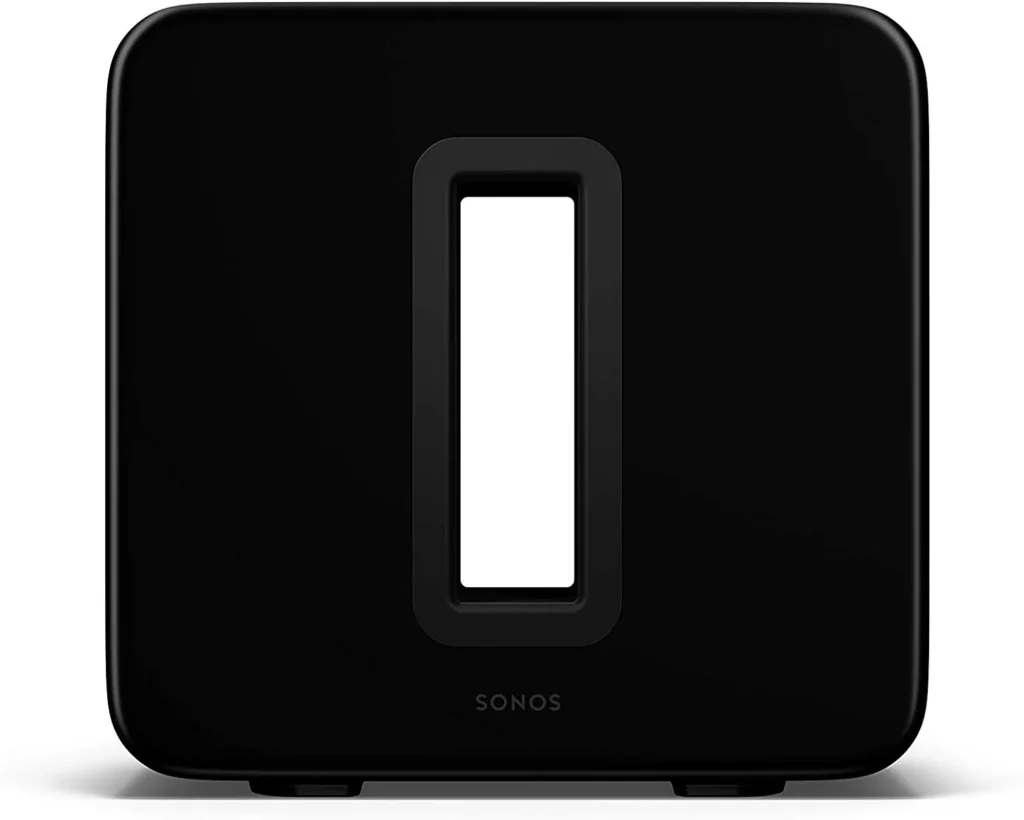
Why is the Sonos Sub (Gen 3) rated the best?
Benefits of Using Wireless Subwoofers
Wireless subwoofers bring a range of benefits that make them a popular choice among audio enthusiasts. First and foremost, their wireless nature eliminates the need for long and unsightly cables, giving you the freedom to position your subwoofer anywhere in the room. This flexibility allows for better sound distribution and ensures an immersive audio experience.
Secondly, wireless subwoofers offer ease of installation. With no cables to connect and hide, the setup process becomes a breeze. Simply pair the subwoofer with your audio system, and you’re ready to go. This simplicity is especially appealing to those who are not tech-savvy or prefer a hassle-free installation process.
Additionally, wireless subwoofers are known for their powerful and deep bass reproduction. They excel at reproducing low-frequency sounds, adding depth and richness to your audio. Whether you’re watching an action-packed movie or listening to bass-heavy music genres, the impact of a wireless subwoofer is unparalleled.
Wireless Subwoofer Buyer’s Guide
We’ll get into the more technical stuff here to give you a better review of the subwoofers we have chosen and why! We’ve also linked a few articles we found helpful that give you a little bit more depth on each specific sub.
1. Sonos Sub (Gen 3)
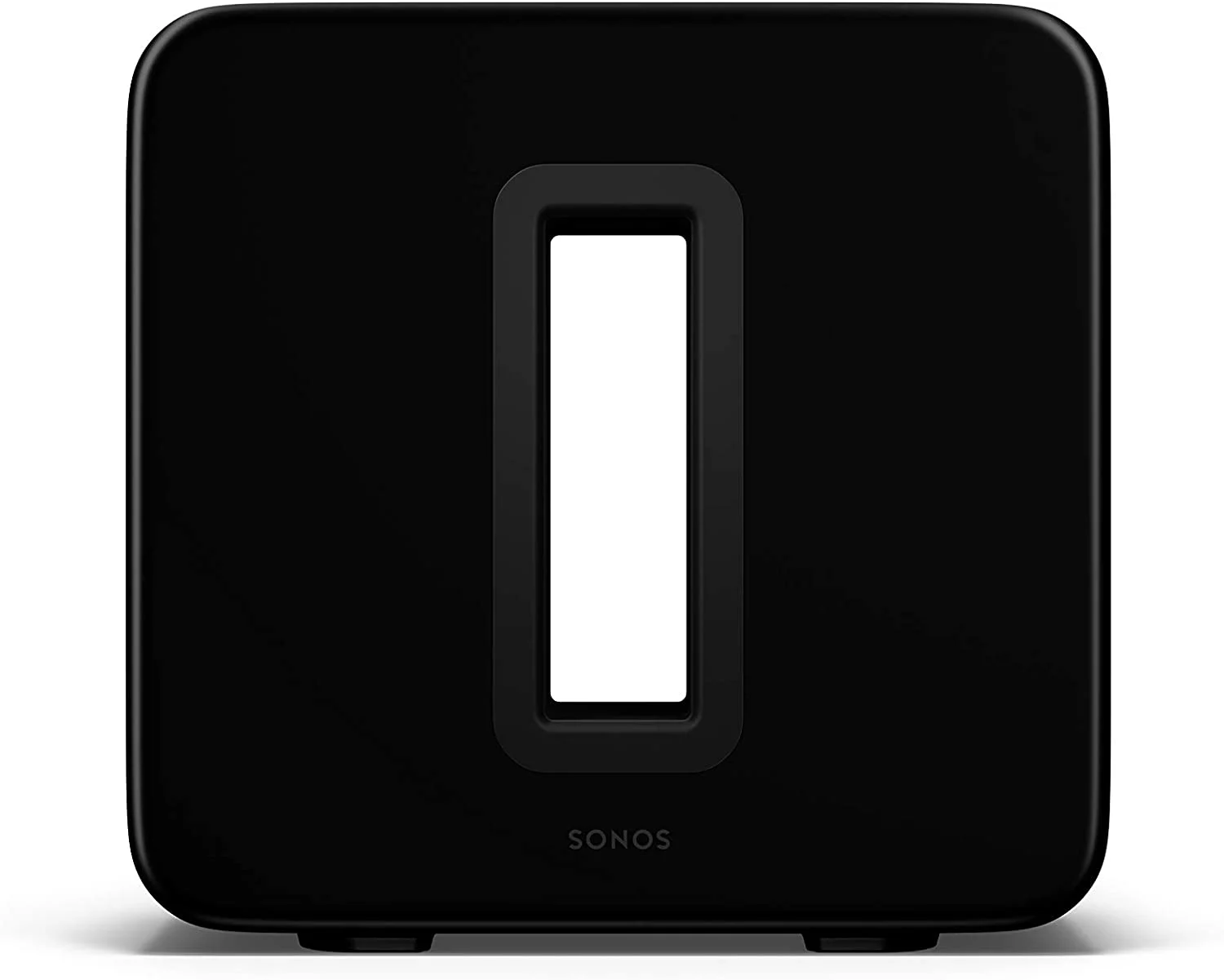
Available in black or white
Product Dimensions: 15.3 x 15.8 x 6.2 inches
Item Weight: 34 pounds
Manufacturer: Sonos
Speaker Type: Subwoofer
Connectivity: Wi-Fi
Special Feature: Designed to Eliminate Distortion; Slim Design; Trueplay Tuning Technology; Simple Setup
This is our favorite wireless subwoofer system. It has a sleek design, easy-to-work controls, and a hassle-free setup. Let’s go into a little more detail…
We chose this one as it’s good value for money with all the features and high-end quality you receive.
We know some prefer the bass to boom and rattle with subwoofers. if this is you – our rank #2 is more suited to you.
Features
We love the no buzz/vibration provided by the 2 force-canceling drivers. This means you can enjoy the sound with no distortion or fear of things falling.
We also enjoyed the versatility, as the design was slimmer in comparison to the average sub. It also can be placed upright or laid flat with no compromise on sound quality.
This means you can either display it stood up or if you want a more subtle look, it can be easily hidden.
You don’t have to worry over the placement of Sonos Gen 3 as its internal software analyses the room’s acoustics. It adjusts its settings to suit any room and uses your mic on your mobile for fine-tuning for the best possible experience.
Set-up can be as easy as a click of a button and volume adjustments can be made via the Sonos S2 app.
Whilst the design is the same as the Gen 2. The benefits of a faster processor, larger memory capacity, and a more powerful wireless radio are worth the extra buck.
Things to Consider…
Unfortunately, as this is a Sonos product it is only compatible with wireless Sonos speakers particularly, the Arc or Beam.
However, you can mix and match but this is a powerful sub and could be a little overpowering for certain single speakers such as Sonos Five or 11SL.
If you have a single Sonos Five or 11SL speaker we would recommend pairing it with another speaker before an upgrade to a sub like this.
Another obvious thing to consider is the expensive price tag. We know subs can be pricey and this is far from a budget subwoofer.
In conclusion, with all of the advanced features, fast processor, and large storage we know you won’t be disappointed!
Here you can find a full review of the system if you want to know more about the Sonos Gen 3.
2. Klipsch SPL-150
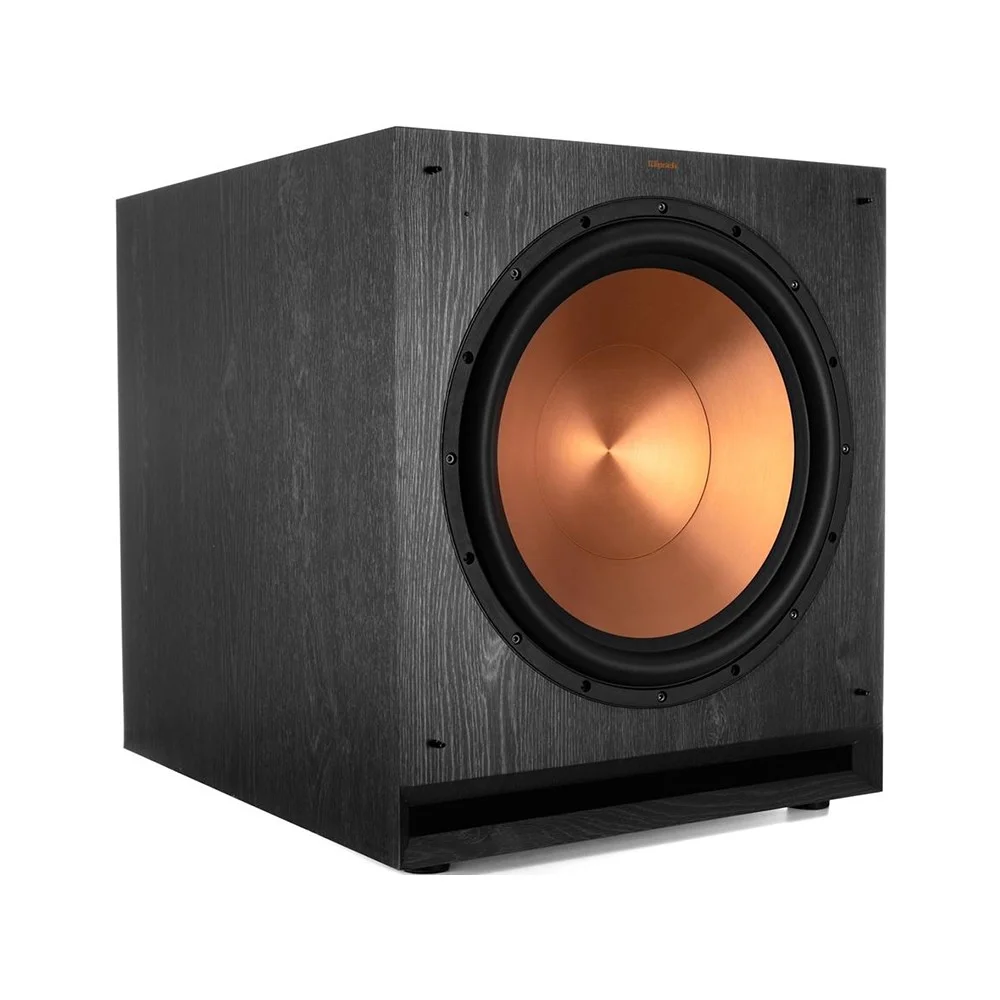
Product Dimensions: 22.3 x 19.5 x 21.5 inches
Item Weight: 75 pounds
Manufacturer: Klipsch
Speaker Type: Subwoofer
Connectivity: Wireless
Special Feature: Front-firing slot Port with Internal Flare; Low-Pass Crossover and Phase Control, Spun-Copper Front-Firing Cerametallic Woofer; Class-D Amplifier
We choose to rank the Klipsch SPL-150 at #2 as a very close contender to our top subwoofer.
It is no secret we were torn between the two since they are both great quality pieces of equipment.
This one does have more of a classic subwoofer look with a stand-out copper finish we know many admire with the Klipsch collection including ourselves.
However, the chic, eye-catching design is not all we love about this one…
Features
We like the use of the front-facing long slot port – not all subs have these. They are very useful to help with the ‘chuffing’ sounds associated with a traditional tube.
This allows the sub to be placed easier in the room allowing a steadier flow of air to circulate through. So you can get the best quality sound without the risk of blocking it and causing it to distort.
This wireless subwoofer can also be paired with any wireless-compatible speakers/soundbars. This makes this an easier choice without having to buy full sets of one-brand equipment.
Despite its large size, it’s light weighing in at 75.3 lbs compared to similar-sized subs. If this 15″ model is too large for you there are also 10″ & 12″ sized options available depending on the size of your room.
Things to Consider…
This subwoofer delivers on bass quality, kick-ass clarity, and its insane ability to reach very deep LFEs (low-frequency effects)…
But subtly and speed is not its strongest points. It is a large unit and it will cause things to vibrate and rattle so don’t expect the neighbors to love it.
The sub’s control panel is unfortunately located on the back and doesn’t come with a remote.
Fortunately, it is a super simple control panel. It is located in the top area of the back and does have an auto-off mode. You can also download the Klipsch Connect app you can use to control from your seat.
Like our first pick, this wireless subwoofer is not cheap. So if you are looking for a more budget-friendly sub then the search may have to continue.
However, we do believe there are a lot of awesome features that justify the price of the Klipsch SPL-150. If you’re looking for super crisp bass that shakes the room this could be for you.
Can’t make your mind up? Why don’t you check out this review on the Klipsch website for more information on the in-depth features and specifications?
3. Bose Bass Module 700

Product Dimensions: 11.6 x 11.6 x 12.88 inches
Item Weight: 30 pounds
Manufacturer: Bose
Speaker Type: Subwoofer
Connectivity: Wireless
Special Feature: Powerful, Wireless connection
In ranking at #3, we have our Bose Bass Module 700. Its sleek appearance helps it blend in whilst delivering some amazing quality.
We are pleasantly surprised this model from Bose could deliver such high performance so had to make room for it in the top 3.
Features
The compact size of the sub allows you to save on space without compromising on sound quality.
Like our second choice of sub the Bose has a long, thin slot port located discreetly on the front.
This allows the sub to perform at its best, tuned, and most clear no matter where you place it.
The subwoofer also includes features such as QuietPort technology.
Which allows it to play at higher volumes with lower distortion and leveled frequencies. Which some other subs struggle with.
When paired with the matching Bose Smart Soundbar 700 the cohesion and clarity between them are like butter. They complement each other perfectly to offer a great sound experience.
It is compact compared to other subs with this kind of power. However, it does weigh more than double its previous 500 models weighing in at 30 lbs.
But, the extra weight does equate to the improved 10″ robust driver, tempered glass top, and other great features.
However, the extra weight does equate to the improved 10″ robust driver, tempered glass top, and other great features.
Things to Consider…
This particular model is made to be paired with the Bose Smart Soundbar 700.
It can also be paired with Bose Smart Soundbar 300, Bose TV Speaker, Bose Soundbar 500, SoundTouch 300 soundbar, Lifestyle 600 system, and Lifestyle 650 system.
Unfortunately, it can only be paired with the other Bose products listed and no other brands of setup.
Even though it does say hassle-free setup we found the setup to be quite lengthy. There was a lack of a customized setting and it does need the Bose Music app download for basic sound setting controls.
This does not mean you can’t get a great sub on a budget and we may have some more suited to you coming up!
As well our other top 3 subwoofer choices the Bose Bass Module 700 comes with a hefty price tag. We have concluded for some of the best features and bass quality it does come at a cost.
4. Klipsch 12″ (R-12SWi) (Best Value)
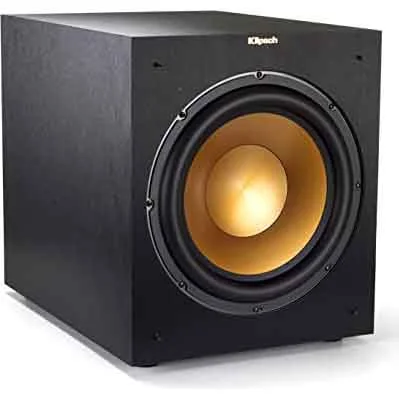
Product Dimensions: 18.5 x 14 x 16 inches
Item Weight: 37.4 pounds
Manufacturer: Klipsch
Speaker Type: Subwoofer
Connectivity: Wireless
This may not be our best-rated wireless subwoofer. But we have awarded it the title of the best budget subwoofer.
We were particularly impressed with the quality and features it offers for its cheaper price.
Features
The impressive sub allows you to listen to music with minimal cone distortion as it provides a low-frequency response.
The sound quality kicks ass and the bass is good.
Maybe not to the standard a true audiophile can fully appreciate as it can’t go as deep as high-end subwoofers.
But for someone just looking to enhance the bass on your speakers, it is perfectly suited.
The design is sleek similar to the Klipsch SP-150 design we have seen and weighs in at 33lbs, making it a larger model.
Hooking it up with speakers is hassle-free. Also, like other Klipsch models, you don’t have to have a full Klipsch setup to enjoy this as it will connect to any brand of speaker through a receiver.
For the price tag, we simply cannot fault this sub. We have rated it its own special title of ‘best value’.
It may not compete with some features high-end subwoofers offer, but if you don’t want to spend the earth then it is perfect. It certainly gives you a lot for the price.
If the 12″ seems a little excessive for the size of the room you have there is a 10″ option also. This one is more suited to larger-sized rooms.
Things to Consider…
If you add an amplifier into the mix this can prove a little difficult for this particular model. This is because it has no high or low-level input or output ports. Some older generation amps need this to connect which can make this process a little troublesome.
The controls are located on the back and not in the best placement which can make them difficult to access until you get used to the sub.
Finally, as well as other Klipsch models careful placement is needed as it does rattle things around it, so best not to put it near anything fragile.
You can find more in-depth information on this model on our page Klipsch R-12SW Review
5. Sony SA-SW5

Product Dimensions: 18.67 x 10.79 x 19.69 inches
Item Weight: 28.7 pounds
Manufacturer: Sony
Speaker Type: Subwoofer
Connectivity: Bluetooth
Special Feature: Omnidirectional Block Design; Deep Bass and Further Clearness and Fidelity; Easy to Set Up
We chose the Sony SA-SW5 as our fifth favorite wireless subwoofer.
It has a minimal design, and a nice textured finish, and can nicely blend in with your home decor.
We were impressed with the rich bass quality from Sony. The sound cohesion with the compatible speakers complements each other brilliantly.
Features
This model includes a notched edge and a magnetic circuit which is something not a lot of subwoofers have.
The notched edge improves vertical amplitude symmetry which is perfect for clear sound quality.
In addition to this, it also helps control the stress inside and outside the diaphragm.
This helps eliminate those distortions you hear with a lot of standard subs.
The magnetic circuit allows it to offer a clear sound by maximizing the magnetic force. The difference is other subs leak a lot of magnetic force.
This is due to using a conventionally shaped circuit instead of the Σ (Sigma) circuit the Sony has.
The setup is straightforward and hassle-free and takes a minute with A9/A7000/A5000 soundbars. (This subwoofer is only compatible with these soundbars).
They all display a small light when they are active. This is helpful to show you everything is working correctly, synchronized with your TV powering on and off.
This model also includes an immersive AE feature for music listening. It is also compatible with Dolby Atmos for a great surround sound listening experience.
Things to Consider…
This model is not a stand-alone sub. It does need the matching soundbar to get a working setup.
It’s not enough bass to rattle the room. This could be seen as a pro for many, but some audiophiles may find this underwhelming if you’re looking for that booming type of bass.
This type of sub and soundbar combo is more suited to a home cinema setup.
You may want to consider other options if you’re looking for a more music-based experience.
In saying this we were impressed with the music quality. You can also connect your phone directly to the soundbar and subwoofer.
We realize this could be a considerable extra cost for an accessory component especially if you haven’t already purchased one of the compatible soundbars.
Although the quality makes it worthwhile, adding the Sony SA-SW5 does dramatically change the audio quality of the setup.
If you were willing to part with the money for an awesome sound experience it is worth it!
6. Mackie CR-X Series, 8-inch
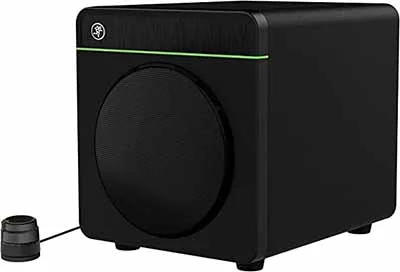
Product Dimensions: 16.15 x 14 x 12.6 inches
Item Weight: 28.3 pounds
Manufacturer: Mackie
Speaker Type: Subwoofer
Connectivity: Bluetooth
Special Feature: 8″ Polypropylene Coated Woofer; 200W of Amplification; Built-In Bluetooth Receiver
Now comes #6! The Mackie CR-X Series is similar a price to our Klipsch 12″ (R-12SWi) and it also connects to any brand of Bluetooth-enabled speakers.
Making this a cheaper alternative and you don’t have to buy a full setup.
Features
This sub is awesome value and offers a moderate amount of bass for the price range.
You can get a full Mackie speaker and subwoofer pair for under $400.
It also includes a CRDV desktop remote that allows you to control the input and output levels. This controls not only the subwoofer but your speakers too.
We were pleasantly surprised with the portability of the subwoofer.
Along with its nice sleek, outlined design with a brushed metal grille, and its setup was hassle-free.
Things to Consider…
Unfortunately, the power button is located on the back. It doesn’t have an auto-on and off feature which may make you consider the placement better.
This is regarded as a desktop sub. Although is compatible with home cinema setups, it is better suited for listening to music and producing it on a desktop setup.
Although great value for money, this is best described as an entry-level subwoofer. If you are new to the sound game and are looking for a little something to enhance your music experience this one could be for you!
In conclusion, for the more experienced audiophile, this level of bass could sound underwhelming even at its full power. Besides, it offers great quality for a lower price point.
7. Polk React 7″ Subwoofer
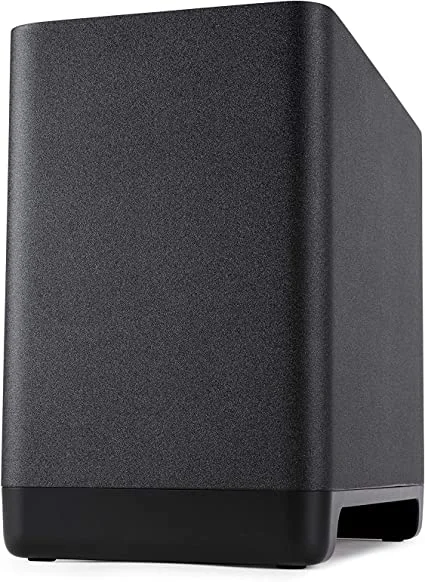
Product Dimensions: 8.56 x 16.43 x 13.62 inches
Item Weight: 19.53 pounds
Manufacturer: Polk
Speaker Type: Subwoofer
Connectivity: Wireless
Special Feature: Long Bass Reach, Tight Bass Impact
Finally, we have the Polk React 7″ Subwoofer ranking in at #7.
Last but not least, we were impressed by this sub’s ability to enhance everything, improving your movie experience.
Features
The Polk React Soundbar and sub combo work well together.
They give an effortless balanced delivery that can all be controlled by the simple sound of your voice with Alexa integration.
The design is minimal, smart and, can blend into any part of the room.
It also includes a downward-facing bass port for added depth.
It is a hassle-free setup by clicking one button. It takes less than 5 seconds to connect to the soundbar and be fully functional and ready for you to test out the awesome audio.
This Polk setup is great value, allowing you to have a soundbar and subwoofer set up for under $500.
Things to Consider…
The Polk React 7″ Subwoofer is only compatible with the Polk React Soundbar and unfortunately, they are sold separately.
If you have other branded speakers and were looking for a sub, this option could turn out costly needing to buy a full setup.
It would be more cost-effective to buy a single, high-quality subwoofer compatible with any wireless speaker/soundbar.
It is also not compatible with immersive audio types such as Dolby Atmos.
It is also only limited to ‘lossy codecs’ which means it compresses the original file sometimes causing lost data and quality.
Polk has chosen to focus on delivering the basics well and still holds its own for the low price.
This is an Alexa integrated sub and soundbar combination and using it without Alexa is not an option. So definitely something to consider if Alexa is not for you.
Overall, it’s a very worthy contender for an accessory to a soundbar.
It is very capable of meeting your musical and movie needs if you’re looking for something more cost-effective. (Providing you already have the other components)
Summary: Enhance Your Audio Experience With a Wireless Subwoofer
Wireless subwoofers have revolutionized the audio industry, offering a convenient and clutter-free solution for deep and impactful bass. Whether you’re a movie lover, music enthusiast, or avid gamer, adding a wireless subwoofer to your audio setup will elevate your experience to new heights.
In this article, we explored the benefits of wireless subwoofers, delved into how they work, and discussed important factors to consider when choosing one. We also provided a guide for troubleshooting common issues.
Additionally, we highlighted some of the best wireless subwoofers on the market and compared the pros and cons of the options.
Now, it’s time for you to unleash the power of bass and take your audio experience to the next level with a wireless subwoofer. Whether you’re immersing yourself in a movie, enjoying your favorite music, or gaming, the deep and powerful bass will transport you to a whole new world of audio bliss. So go ahead, choose the perfect wireless subwoofer for your needs, and let the bass take over.
Choosing The Right Subwoofer System
Picking the right subwoofer can be hard. Especially if you’re not exactly sure what you’re looking for and certain things to look out for to find the best-suited one for you.
1. How much bass does the room need?
You may want to consider the size of the sub. Not cosmetic aspects but things such as how powerful it will be for the room it is placed in.
Getting a huge, powerful subwoofer for a small-sized room could run the risk of becoming overbearing.
It’s important to look not only think about the length and width of the room but also the height. For example, if you have a room that is 1500 cubic feet or less we would recommend a 10″ sub.
However, if your room is somewhere between 1500-3000 cubic feet we would recommend a 12″ sub. Anything more than this we would recommend getting a super high-end subwoofer to get the best experience.
If you’re still unsure about this then we recommend watching this video for a little more info…
2. What purpose would you like your sub for?
Would you like to use it more for movies, music, TV, or all of those? Think of what you want out of it and what you prefer to do the most.
Ported
…So the big question is sealed or ported? If you want to use it for more TV and movies many would recommend choosing one with a bass port.
Subwoofers that include a bass port on our Best Wireless Subwoofer list:-
Klipsch SPL-150
Bose Bass Module 700
Sony SA-SW5
Polk React 7″ Subwoofer
This is because a sub with a bass port can recognize more subfrequencies than a sealed one. Its low-end bass extension can make those rumbling scenes and explosions sound insane!
It also needs less power to get to the same bass level due to it having the port.
The downside to this is the majority of the ported subwoofers are large. So, the tight bass you need for faster music genres such as heavy metal, rock, and heavy techno to name a few is lacking.
Sealed
If you want your wireless sub for mainly music reasons, many would recommend a sealed port. This is because they are usually more compact with tighter bass as it is all being concealed.
Sealed subwoofers on our Best Wireless Subwoofer list:-
Sonos Gen 3
Klipsch 12″ (R-12SWi)
Mackie CR-X Series
For example, music with fast-kick drums would be perfect for this type of model. It’s pressurized and this allows the woofer to back and forth really fast having a quicker response to the music.
The con for a sealed sub is you’re going to have to give the sub a lot more power to achieve the same type of rumble of a subwoofer with a bass port.
This generally excludes Sonos Gen 3 which is already a high-end powerful sub. It contains dual acoustic ports so this sub can be both tight and precise whilst hitting the deep lows.
Summary
A question like “Do I go sealed or ported?” Is sometimes not an easy one to answer.
It depends on what type of things you want to use it for. The general ‘sealed is for music’ rule sometimes doesn’t apply depending on what type of genres you often play.
For example, If you like hip hop, reggae, and, other slower genres that use a slower bass rhythm then a bass port still might be better for you.
Overall, the best thing to do is buy the two wireless subs you like the look of and after you’ve decided on the correct one, return the other. To try them in your chosen room is the best way to find out.
We have linked another video for you to check out that we find helpful!
Passive vs Active Subwoofers
An active subwoofer or powered subwoofer contains a built-in amplifier. They usually have a much more intense sound with more impact. These usually come as a much larger piece of equipment.
A passive subwoofer relies on a separate amplifier or A/V receiver to be powered. There are usually smaller and better suited to smaller rooms.
Active Subwoofers
Active subwoofers are often more expensive but have a much better sound quality. They tend to be a larger piece of equipment and not as easily portable.
They also work well with sound setups that have other components. These are things like surround sound speakers, sound bars, etc.
Yet, if your active subwoofer has speaker inputs, it can also be used as a passive subwoofer. This can be done by plugging the amp lead into one of the two speaker level inputs L or R.
Passive Subwoofers
Passive subwoofers are suited to smaller rooms and are easier to move around.
They tend to be a popular choice when an intense sound could be overwhelming for the size of the room, or it needs to be moved around frequently.
Despite all the positives of active subwoofers, passive subwoofers tend to be overall more popular.
This is because aside from the amp you don’t need to buy any other components and they tend to be overall cheaper so more cost-effective.
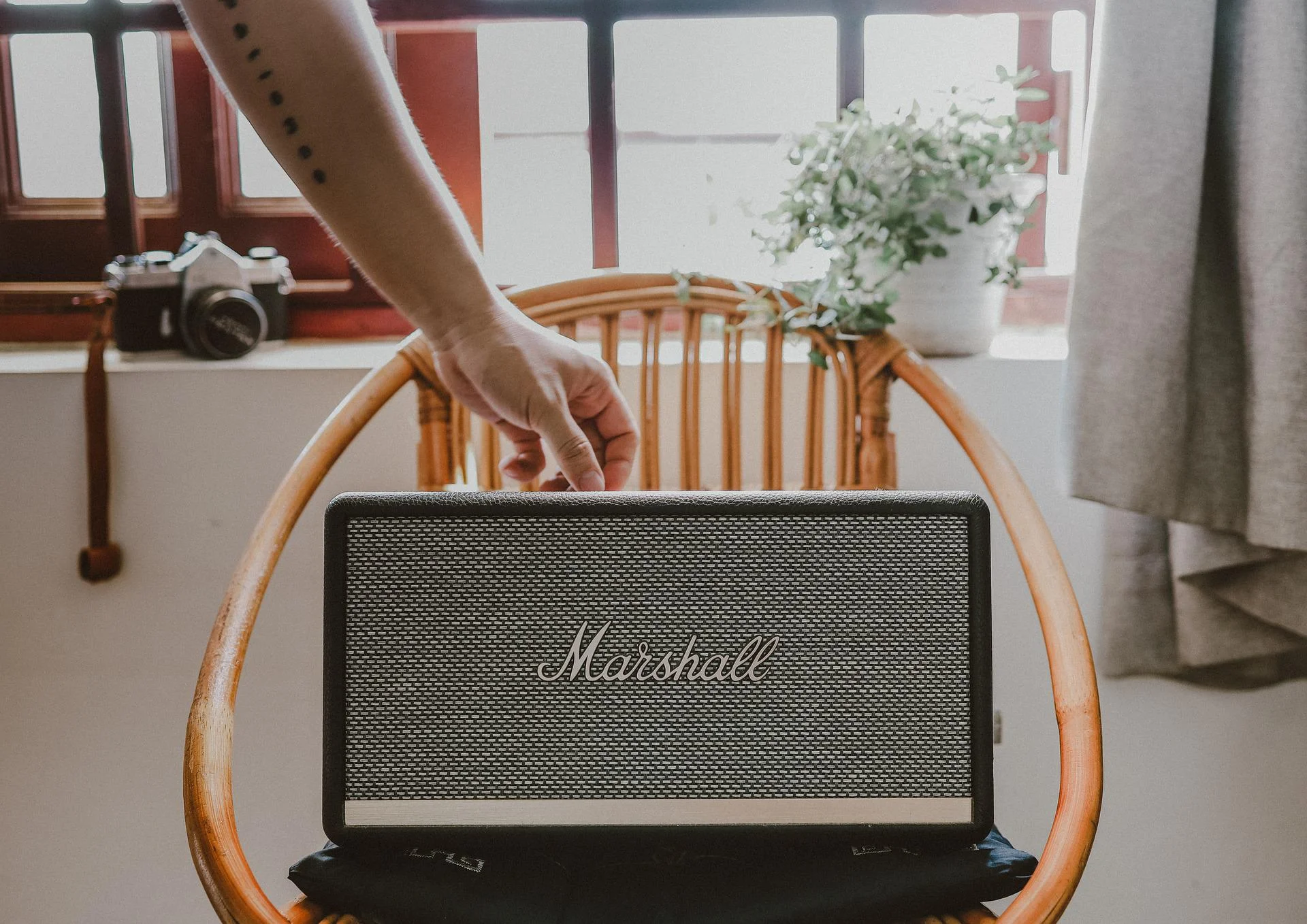
Active and Passive Subwoofers on our list
Sonos Gen 3 – Active
Klipsch SPL-150 – Passive
Bose base module 700 – Active
klipsch 12″ (R-12swi) – Active
Sony SA-SW5 – Active
Polk React 7″ – Active
Mackie CR-X Series – Active
Front-Firing vs Down-Firing
As well as the other differences discussed, subwoofers are made in two different ways. There are front-firing and down-firing subs.
This means where the driver emits sound from on the model. Front-firing is when the sound comes from one of the sides and down-firing is when the sound comes from the bottom of the subwoofer.
Which is better is a difficult question to answer as again, it depends on what you’re looking for.
Front-Firing Subwoofers
Front-firing is more rapid and good for things like kick drums, explosions, gunshots, fast bass, etc.
This makes them better for a lot of genres of music and action-based film.
The sound produced from a front-firing subwoofer sounds light and airy as it doesn’t hit the floor first.
It comes straight to the listener which results in a much punchier, more accurate sound like a conventional speaker.
Although, careful placement of a front-firing sub is needed and cannot be against a wall as it needs air to move around it freely.
Down-Firing Subwoofers
Down-firing pushes the sound out at the bottom of the unit making the waves hit the floor first. This targets the largest surface area and the bass then ripples through the floor.
These units are responsible for the deepest, lowest notes.
This makes a deep, rumbling bass effect – great for that kind of bass you can feel in your whole body.
Down-firing is usually popular for home cinema because they’re great for movies and gaming.
Summary
As always, it depends on what your kind of setup is and what you would like to use your sub for. There is no definitive ‘what is best’ answer for any kind of sub and will always be subjective and down to personal experience.
My answer is the best subwoofer would have both features like the Sonos Gen 3. This is because they both have strengths and weaknesses in different areas.
This means if you have both features then you can use it for various things and experience the best quality every time.
How do Wireless Subwoofers Work?
Wireless subwoofers emit radio frequencies to the audio receiver (the speakers). They do this via a transmitter.
They also receive various types of frequencies such as infrared, Bluetooth, Wi-Fi, and radio frequencies.
This all happens in the air through connections and gives a nice, tidy look. This is because there are no visible wires across the living room.
If you want to hide the subwoofer that is also more possible with a wireless connection.
In the past, things such as microwaves, baby monitors…etc could disrupt the frequencies. Although it can sometimes still happen today, they tend to be more reliable and have stronger connections.
The difference between a wired subwoofer is that it needs a physical cable connecting it to the audio receiver.
Wired subwoofers vs wireless subs that are spec for spec will not compromise on the audio quality and will both have the same sound quality.
With wireless subs, you can also build a more sophisticated setup as it will generally be easier to set up. It will likely be universally controlled and more responsive for a better user experience.
Tips for Optimizing the Performance of Your Wireless Subwoofer
To ensure you get the best possible performance from your wireless subwoofer, here are some tips to keep in mind:
1. Room acoustics: Experiment with subwoofer placement to find the optimal position for your room. Avoid placing the subwoofer too close to walls or corners, as this can affect bass quality.
2. Volume and crossover settings: Adjust the volume and crossover settings on your subwoofer to achieve the desired balance between the subwoofer and other speakers. Fine-tuning these settings can greatly enhance your audio experience.
3. Firmware updates: Check for firmware updates regularly. Manufacturers often release updates to improve performance, add new features, or address any known issues.
4. Regular maintenance: Keep your subwoofer clean and free from dust. Wipe the exterior with a soft cloth and use compressed air to remove dust from the speaker drivers and vents.
By following these tips, you can optimize the performance of your wireless subwoofer and enjoy a truly immersive audio experience.
Troubleshooting Common Issues with Wireless Subwoofers
While wireless subwoofers offer convenience and exceptional performance, occasionally, you may encounter some issues. Here are some common problems and their solutions:
1. No sound from the subwoofer: Ensure that the subwoofer is powered on and connected correctly. Check the volume levels on both the subwoofer and your audio system. If using Bluetooth, ensure that both devices are within the specified range.
2. Interference or dropouts: If you experience intermittent sound or dropouts, check for any sources of interference such as other wireless devices or thick walls. Relocate the subwoofer or audio system to minimize interference.
3. Audio delay: If you notice a delay between the audio and video, adjust the audio delay settings on your audio system or consider using a wired connection for reduced latency.
4. Weak or distorted bass: Check the subwoofer’s placement and ensure it’s not too close to walls or corners, as this can affect bass quality. Experiment with different placement options to achieve the desired sound.
If you encounter persistent issues, consult the troubleshooting section of your subwoofer’s user manual or reach out to the manufacturer’s support team for further assistance.
If you have an LG subwoofer pair it with your TV in these few steps…. or find out if LG subwoofers are worth it.
FAQs
Do wireless subwoofers sound good?
Wireless technology has come far in recent years and we are always impressed by the quality of modern-day wireless subs.
You can now get high-end wireless subwoofers that sound amazing and can reach those powerful, booming lows as good as cabled ones.
Not to mention, generally less hassle to set up and they look better without all those wires so better all around.
How far can wireless subwoofer work?
It all depends on the model and product specifics.
This should say on either the box or instructions. But on average the sub should be placed within 10 feet of the soundbar or speakers but most can connect up to 30 feet away if necessary.
Do wireless subwoofers have a delay?
The answer is simply no.
Radio signals travel faster than electrical signals so your sub should be very responsive.
Only faults in the radio circuits could cause a noticeable audio delay, not the signals themselves.
Should a subwoofer be placed on the floor?
This depends on what you’re listening to, the room acoustics, and how portable your sub is.
If your sub is large and heavy the floor with a little room in between the sub and the wall is the best place for it.
This will allow the vibrations to intensify and give you an immersive experience however can pass to adjacent rooms.
If your sub is a little smaller and more portable you could place it on a stand or cabinet.
This will reduce the intensity of the vibrations and prevent them from traveling to other neighboring rooms.
Allowing it to fill the room with bass evenly.
It’s worth trying out a few areas to find the perfect one for you. Subs like the Sonos Gen 3 can self-adjust to fit the place you put them in making where you choose to place it more convenient and flexible. For this reason and a few more, it is our best wireless subwoofer.
Does a wireless subwoofer need to be plugged in?
Yes. The wireless feature is more referring to the connectivity to other components such as speakers, soundbars, phone connectivity… etc. You will still need to plug these devices into an AC wall outlet or power strip.

Written By Emily
If you liked this list, find more content like this to help find the best subwoofer for your preferences.
